G503.com GPW Judging Standard WIKI-BODY - EXTERIOR
6.0.1 Grille
6.0.1 Grille
Grilles produced before sometime near mid-April ‘42 did not have indent to
provide clearance for seam in center of hood.
Hood welting rivets: Rivets installed head-up with legs bent under lip of
grille. These rivets were S2 finished.
Air seal “felt”: Original was some sort of burlap cored, coarse fiber felt.
This seal was attached to the grill air shield sheet metal with wire staples
which should be visible from the exterior of the vehicle.
Headlight hinges & hardware: Ford headlamp brackets are distinguishable
from the Willys type by noting that Ford hinges are spot welded to the lower
side of the brackets. The brackets are fastened to the grille with two
cone-point hex bolts each. The bolts are installed from the bottom (i.e with
nuts up) and the hinge brackets are to be fastened underneath the top flange of
the grille. The hinges should not show wear form contact with the hood.
Updates to this info below this line
Grill Differences.
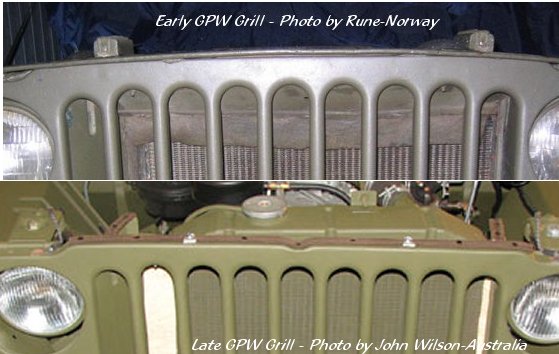
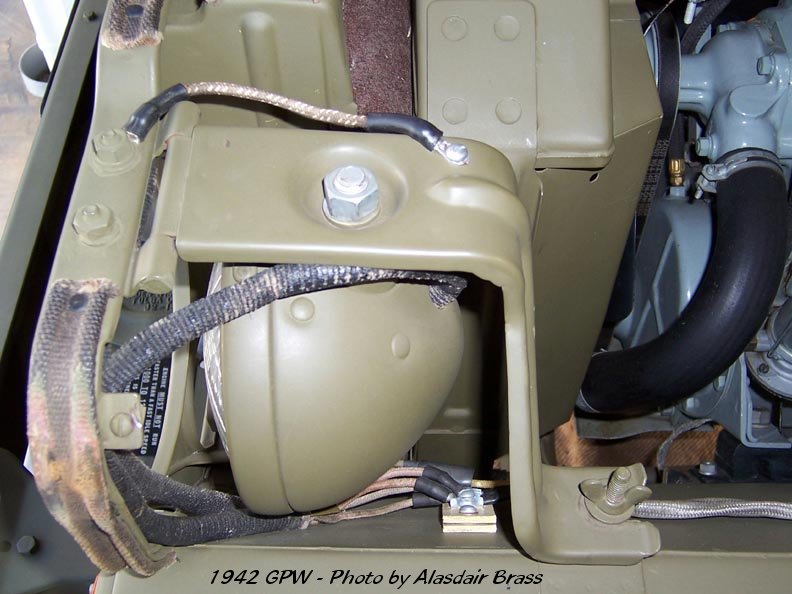
6.0.2 Hood
6.0.2 Hood
GPW hoods use a three piece rear stiffener, spot welded to the hood sheet
metal. The hood is wired along the front edge. Ridges from the wiring machine
should be clearly visible.
GPWs did not have “air baffles” installed on the leading edge of the hood as
were used on early MBs. GPW hoods did however retain the stamped “dimples” where
the baffle mounting screws would have gone, and these should be visible.
See the “Radio Suppression” section for information on hood grounding.
Hold downs : Hood clamps and windshield hold-down clamps are to be
painted O.D. The attaching hardware should be hex bolts ( f head for
pre-1944 vehicles), painted O.D. on the exterior of the vehicle and either
painted or left bare on the underside of the hood.
Hood blocks: From start of production thru July 1942, green rubber hood
blocks were used. By late July production had switched entirely to wood/fabric
hood blocks.
A lube chart holder was added to the underside of the hood around November or
early December 1943.
Grease gun: The grease gun bracket, located on the left underside of the hood
was incorporated around March or April 1944. The only correct grease guns for
this bracket were Alemite 6593 or Lincoln 1078. The early grease gun (in tool
bag 41-B-15) was an Alemite 5585.
Updates to this info below this line
Bracket-Under
Hood
Lincoln
1078
Alemite 6593
Alemite 5585
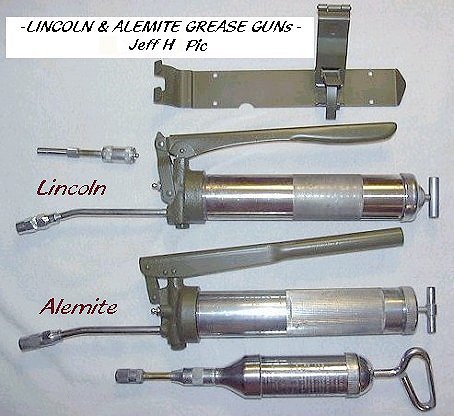
6.0.3 Fenders
6.0.3 Fenders
GPW fenders were “F” marked on top until late ‘44
GPW fenders have a single piece inner panel which is easily differentiated
from the MB front fenders multi-piece fabricated inner panel.
Spot welds should be visible, grinder marks on fender top spot welds may be
visible. Wired edge with serration marks from wiring machine.
Updates to this info below this line
Both fenders on my Jan 45 GPW have distinct deep f marks. The July 45 GPW of
Tony Sudds also has both fenders f marked. This would suggest that the point of
embodiment of non-marked fenders was dependent on old stocks being used up first
and also suggests that every factory would have different dates of change over.
6.0.4
Windshield
6.0.5 Body Tub
6.0.5 Body Tub
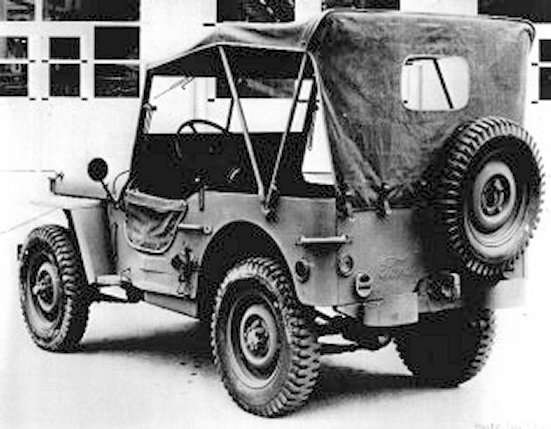
Script GPW of approx. 4/42 production. Note 3-stud spare wheel carrier,
rubber ring surrounding tail lights, lack of liquid container bracket, round
reflector housings and light colored binding tape on canvas top.
Ford manufactured their own body assemblies from start of production thru
Sept. ‘43*. Ford manufactured bodies are easily recognizable by the rectangular
recess around the tool box locks.
The early American Central body was introduced around October 1943 and was
used until Jan. ‘44. Composite bodies were introduced between Nov ‘43 and Jan
‘44 and were utilized exclusively after Jan. 1944.
Note: When the American Central Body Company, manufacturers of the jeep
bodies for Willys-Overland reached volume production, Ford decided that it would
cease production of the Ford designed body which were all built at the lincoln
plant. Supposedly, Ford was not completely satisfied with the Willys designed
body, so Ford met with Willys-Overland and the Ordinance Department to discuss
building a composite body, which would incorporate the best features of each
body design. As a result, it was decided that the Ford design would be adopted
for the following sub-assemblies: Complete hood, cowl, dash, rear panel tire
carrier and front floor reinforcement. The remainder of the body was to use the
Willys design.**
The “Ford” script rear panel was used from start of production thru late July
‘42. Factory documentation shows that the liquid container carrier hardware was
incorporated in the rear panel production the week of 1/25 1943***. Removal the
registration number from the rear panel was probably concurrent with the
introduction of the liquid container carrier.
On 2/8/43 the rear panel to wheelhouse reinforcement plates were incorporated
in factory production.****
* Jim Gilmore’s archival research shows that the first Ford GPW body was
assembled 12/17/1941, The last was shipped 9/16/1943. ** Ford archive
research, Lloyd White. *** “Ord. Dept Report” AAW#2, p223 shows this date
as 3/9/43 **** Information provided by Jim Gilmore based on archival
research.
Updates to this info below this line
A characteristic of the Ford tubs that was carried through to the ACM1
and ACM2 bodies was the indent in the front passenger floor in line with the channel
that runs from the front out towards the back and side. This was where the
exhaust bracket was mounted. -Andrew Cranfield -
6.0.6
Body Hardware
6.0.7 Top bows & brackets
6.0.7 Top bows & brackets
GPW top bows are formed of 1” diameter heavy walled steel tubing. The
radiused corners of the bows are smoothly formed, with no “cave in” on the outer
edge of the radius. Tubing ends are swaged over a reinforcement piece so that an
end-on view of the end shows 3 layers of steel. The two bow tubes are riveted at
the hinge and there is usually a script f on the secondary bow on the
inside, near the swaged end.
Top bow swivel brackets are formed of heavy gauge steel and striations are
visible on the surface of original pieces from the stamping process.
Reproductions do not have these striations. Swivel brackets are stamped with a
prominent script f.
Top bow swivel castings are marked with a script and GPW 1151270.
Top bow retainer brackets (also called “hand rail brackets”) are made from 16
gauge steel and machine forming striations are apparent where the top loop is
formed. Left and right brackets are different as the position of the locating
rivet is different for left and right. Both left and right bracket stampings
have holes for both rivet positions. These brackets have a prominent script
f near the screw holes.
Updates to this info below this line
6.0.8 Paint
6.0.8 Paint
The GPW body was finished in dead flat synthetic olive drab enamel. The early
GPWs* were painted a shade of OD which has a pronounced green hue when compared
to the brown tone of FS #34087. Flat OD paint is extremely prone to grease
stains, “polished” areas from contact with clothing, etc. and scratches. When
GPWs were delivered from the factory, standard equipment included a fair number
of grease stains and points should not be deducted for stains that resemble
those which would have resulted from factory assembly. The finish should however
be free of scratches or other wear that would appear to be the result of regular
use since the standard is a vehicle as delivered from the factory.
* No documentation has been uncovered to date concerning a change in body
color, however this green hued paint color has been observed on numerous GPWs
from 3/42 through 4/43.
Updates to this info below this line
6.0.8 Markings
Factory markings included the U.S.A. Registration number
on both sides of the hood and on the rear panel of vehicles not fitted with the
liquid container bracket.
GPW's which completed the radio interference suppression
tests were marked with the letter S on both sides of the *cowl. Most GPW's were
so marked.
Factory applied markings were lusterless blue drab
throughout the entire production.
Stencils used or applying registration numbers were of
the adhesive backed variety and did not include "webs" for support. Therefore,
all markings should be solid, without web gaps.
Updates below this line
Rear Panel - Early No Liquid Container Bracket
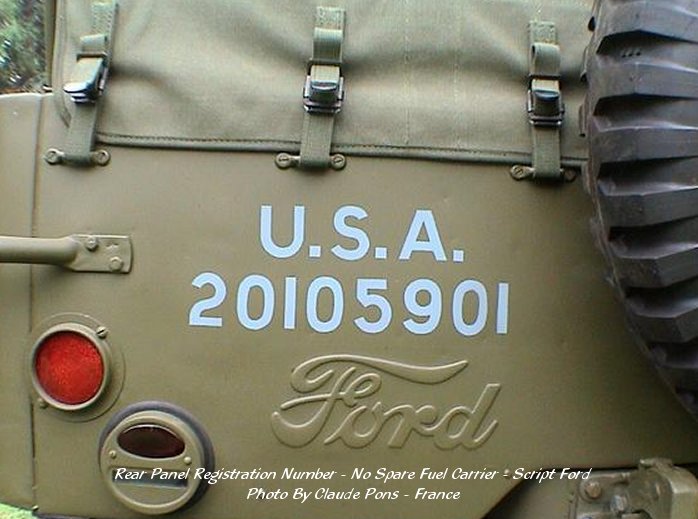
*Late GPW's were marked from the factory with the letter
S following the registration number.- Jon Rogers - JeepDraw
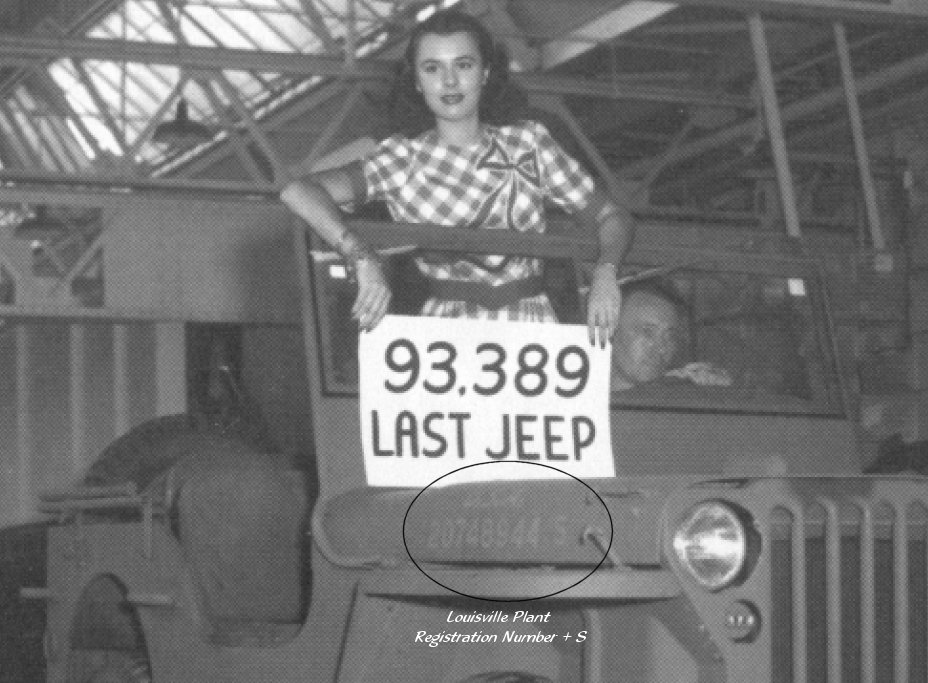
This Web Page Created with PageBreeze Free HTML
Editor





